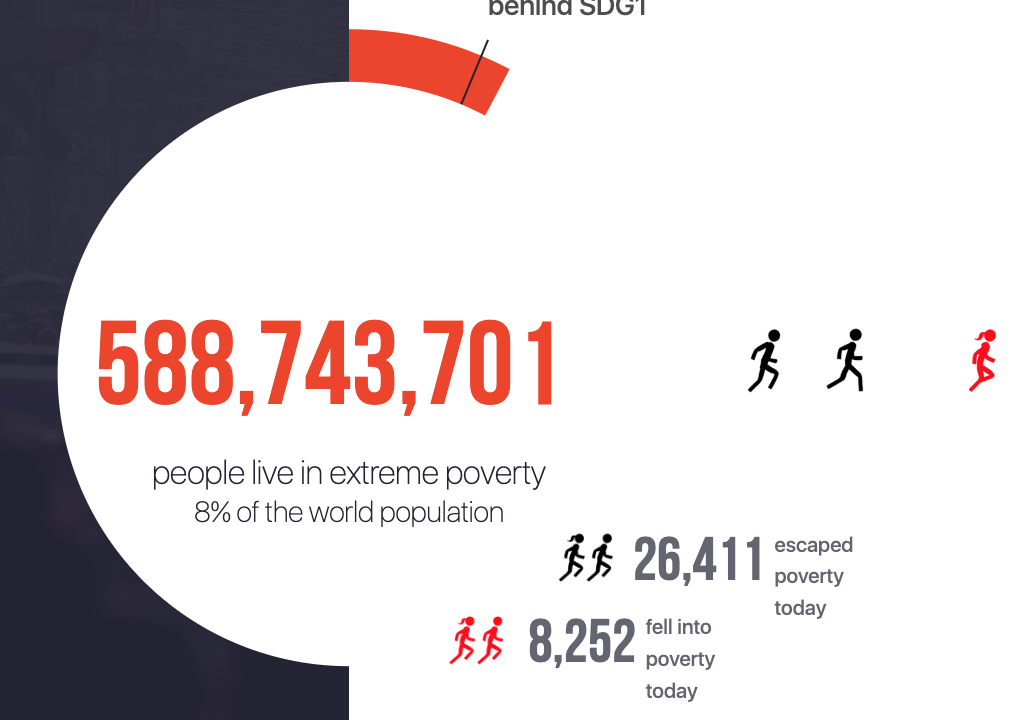End of Year, End of World? Twelve Monkeys: One CDC
The post below Twelve Monkeys: One CDC, was featured June 1, 2007 on Victor Niederhoffer’s Daily Speculations. Twelve years have passed since 2007, bringing astonishing progress, especially for the world’s poorest families. Matt Ridley makes the case that We’ve just had the best decade in human history. (The Spectator, December 21, 2019).
The World Bank reports that even as world population increased by 2 billion from 1990 to 2015: Nearly 1.1 billion fewer people are living in extreme poverty than in 1990. In 2015, 736 million people lived on less than $1.90 a day, down from 1.85 billion in 1990 (Source: Poverty: Overview, World Bank)

World Data Lab runs a clock counting down the people living in absolute poverty. When I checked this morning, the number was 588, 743, 701. And since 2105 some 150 million more escaped absolute poverty.
The post below is about a global warming assembly held at an elite Seattle prep school in 2007 and a strange news story the same day. I argued economic reforms around the world were lifting living standards and would continue to improve the lives of billions. I suggested technology advances would bring more sophisticated and effective technologies to deal with climate concerns as progress continued. [For recent stories on economic development, see this Atlas Network page.]
A steady stream of science fiction movies however, portray a darker, more polluted future, with new technologies and powers in the wrong hands. This year the Avengers wrapped up the Thanos-era and his halve-the-population mission (turned out reducing population by just one was the solution). Anyway, here is the slightly revised 2007 post:
Twelve Monkeys: One CDC…
Like most people I prefer my end-of-the-world scenarios in movies rather than the evening news. But today I was on a global warming panel at a Seattle prep school. Nearly 300 students attended and we were asked to address what students should do to reduce global warming. What could students do, “now that the science has been settled.” I don’t agree the science on global warming is settled, but wanted to participate.
One panelist insisted the U.S. should cut greenhouse gas emissions in half, then in half again. He told students how terrible it was that countries like India and China have to stop growing because the U.S. and Western Europe have already filled the world’s CO2 quota. Another speaker, Washington State’s Meteorologist, told students that air travel creates tremendous GHG emissions, and recommended they stay home and go to movies instead of vacations. He recounted how as a kid he and his friends had a fun one evening just watching trains go by.
At the panel’s introduction, our host, a science teacher at the school, apologized for “yet another assembly on global warming” and said he knew they had all covered global warming in their classes. I can’t help but wonder how much they have been lectured on how CO2 “pollution” and climate change will wreck much of the planet.
In my few minutes I argued that global warming fears are similar to past environmental fears: overpopulation, world famine, running out of resources, pollution, topsoil erosion, species extinction. These fears turned out not to be world-ending problems, and two billion people in China and India have much more to eat on the road to prosperity, even with their semi-communist and semi-socialist governments.
Research shows that as annual incomes in developing countries pass $6,000, much more is invested in cleaner air and water. Even modest prosperity improvements enables practical steps for communities to imprrove their environment, according to their own priorities. (For more see Environmental Quality, The Library of Economics and Liberty)
Investment capital flows to nearly every corner of the world, bringing new agricultural tools and technologies, water purification, cell phones, medicine, books, the Internet, factories, and call-centers. The air is clearing inside millions of homes now linked to electrical and natural gas grids. Sometime recently humanity passed the threshold when less than half the world’s women are no long searing their lungs cooking over wood and dung-burning stoves. (Though maybe sometime soon over half of American men will be cooking over outdoor barbecues.)
However, all this wealth, all this expanding prosperity, is burning hydrocarbons and sending CO2 into the atmosphere. As President Bush called for world politicians to somehow deal with GHG emissions, they knew, or should have known, that CO2 emissions will rise by 70% over the next 15-20 years. And that will be a very good thing for the hundreds of millions breathing cleaner air, drinking cleaner water, and living longer lives.
Still, if I would have said these last points at the assembly, I don’t think I would be invited back to the school. [Turns out I wasn’t invited back. anyway…]

So I came home and watched an end-of-the-world movie to mark the day’s adventure, a movie also inspired by the day’s news. If the end were to come for much of the human race, it is more likely to come as presented in Terry Gilliam’s Twelve Monkeys.
The news emerged through the day of a jet-setting, super drug resistant TB patient, who, amazingly enough, had a stepfather working on drug-resistant TB at the Center for Disease Control. (TB Patient Is Related to C.D.C. Expert on Disease, New York Times, May 31, 2007). In Twelve Monkeys, the research scientist who releases the virus works in a federal virus research lab, and believed overpopulation and man’s footprint is wrecking the planet. 12 Monkeys was made in 1995, and since then many millions of students have been taught various kinds of environmental and climate alarmism in high school and college classrooms.
Only a worldwide pandemic could allow humankind to reach the greenhouse gas (GHG) emission goals set by environmentalists, politicians, and prep school guest speakers. We have to hope that quiet and desperate types at the CDC don’t try to take GHG goals into their own hands.
